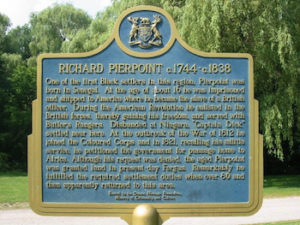
Richard Pierpoint plaque
*The birth of Richard Pierpoint is celebrated on this date in c. 1744. Also known as Black Dick, Captain Dick, Captain Pierpoint was a Black British soldier.
Richard Pierpoint was born in Bundu, what is now Senegal. When he was about sixteen, he was captured and sold as a slave. He survived the crossing of the Atlantic and was sold to a British officer named Pierpoint in one of the northern British colonies; he took his surname and became his servant.
In 1776, with the outbreak of the American Revolution, many Black slaves were offered freedom if they fought for the British. By at least 1780, Pierpoint was one of about a dozen Black Africans fighting with the Butler's Rangers regiment. The enlisted Blacks were only non-combatant laborers or sappers. Following the British defeat, the Rangers settled in Niagara. Among the Loyalists who came to Upper Canada (where they were given the name United Empire Loyalists) were several hundred Blacks (the "Black Loyalists"). Blacks represented about 10% of the total Loyalist emigration during that time. Communities such as the Pierpoint Settlement and the Queen's Bush Settlement were examples of how Blacks created communities and helped develop many communities in Southern Ontario.
Blacks were entitled to the same proportion of land as their fellow white Loyalists. Loyalists first settled in the City of St. Catharines in the 1780s. In 1788, Pierpoint was located on 200 acres of land near present-day St. Catharines. Early histories credit some of Butler's Rangers, among the first to come to the area, taking up their Crown Patents where Dick's Creek and 12 Mile Creek merge, now the city center of St. Catharines.
Although never documented, some local St. Catharines' historians speculate Dick's Creek was named after Richard Pierpoint, a Black Loyalist. There is some evidence that Pierpoint did not arrive alone, but his participation in the Petition of Free Negroes and subsequent sale or abandonment of his grant suggests he may have been single, at least by 1794.
In 1794 Pierpont signed the Petition of Free Negroes to Lieutenant Governor John Graves Simcoe requesting that freed Blacks who had served as soldiers be given land grants adjacent to each other so that the former comrades could help each other with land clearing as many lacked the large families necessary to clear the land on their own. The Executive Council of Upper Canada Government read the Petition on July 8, 1794, and dismissed it. Pierpoint subsequently abandoned or sold his grant and supported himself as a laborer.
Following the War of 1812 outbreak, Pierpoint proposed organizing a Corps of Men of Color on the Niagara frontier. His offer was refused, but a small Black corps was raised locally by a white officer, Jordan tavern owner Robert Runchey. Pierpoint volunteered immediately for Captain Runchey's Company of Colored Men even though he was in his sixties. The corps served with distinction at the Battle of Queenston Heights, the siege of Fort George and the Battle of Lundy's Lane, and other engagements. They were also instrumental in the construction of Fort Mississauga. The corps was used for labor and garrison duty for the remainder of the war. Pierpoint's unit was honorably disbanded in 1815.
As a veteran, Pierpoint was entitled to a 100-acre grant of old-growth forest. In his late 70s, 1821, Pierpoint petitioned Lieutenant Governor Maitland for passage back to his homeland in Senegal instead of the land grant. His request was denied, and instead, Pierpoint and several other Colored Corps veterans were given land grants in Garafraxa, just outside present-day Fergus Falls, Minnesota. A "land ticket" was issued to him on July 30, 1822. Pierpoint would only get full ownership of the plot once he had cleared at least 5 acres of trees, cleared a road to the plot, and built a house: Location Ticket grant on fulfillment of settling duties required by Order in Council of 20 Oct. 1818: to clear and fence 5 acres for every 100 acres granted; to erect a dwelling house of 16 by 20 feet (6.1 m); to clear one half of the Road in front of each lot. The whole process will be performed within two years of the ticket date.
The farm was probably a settlement for several Black Canadian settlers, but the exact number is unknown. Very few records were left, and even orally transmitted history is limited. Richard Pierpoint died sometime before September 1838, leaving no family or heirs. It is not known where he was buried. He left the Garafraxa property to Lemuel Brown. Brown, who lived in the Guelph area at the time of Pierpoint's death, sold the land to the neighboring farmer.